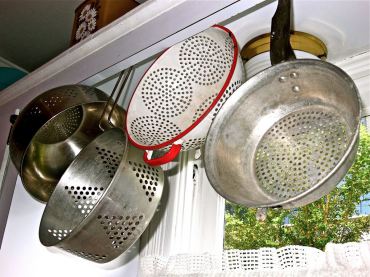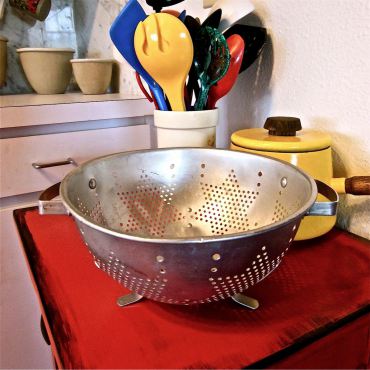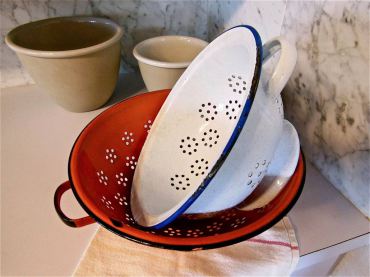 If it weren’t for their utilitarian function, the colanders would probably be displayed in galleries as art pieces. They are that beautiful.
If it weren’t for their utilitarian function, the colanders would probably be displayed in galleries as art pieces. They are that beautiful.
These food-straining devices are little thought of in the world of classic interior design — but are often seen displayed in “cutie country kitschy” settings with purposely frayed, worn, white cabinets and plank-wood floors.
Putting aside the extremes of contemporary minimalism on one end and clutter kitschy on the other, there is us. “Us” with a colander or two somewhere in a lower cabinet mixed in with the pots and pans.
 Not to say they are lost within content. Indeed, these hole-ridden bowls are always at fingertips’ reach. Maybe not thought of in terms of world complexities, but, bet ya bob, that colander is used all the time.
Not to say they are lost within content. Indeed, these hole-ridden bowls are always at fingertips’ reach. Maybe not thought of in terms of world complexities, but, bet ya bob, that colander is used all the time.
What is a colander? Sometimes called a strainer, it is usually round, with a diameter of about 10 inches, and can have three little stabilizing legs and always many holes.
 And those holes can be situated to create designs. Most colanders are enamelware in many colors or a metal and can be hung easily. Also the strainers can be granite, wire mesh or clay pottered.
And those holes can be situated to create designs. Most colanders are enamelware in many colors or a metal and can be hung easily. Also the strainers can be granite, wire mesh or clay pottered.
Not only are colanders a beautiful practical shape, they are inexpensive and bountifully found in most thrift shops. I went on eBay and explored some three-hundred colanders. Most were $10 to $20. Found an antique strainer for almost $500, but that was way out of range and visually not much better looking than the cheap ones.
In the small scheme of kitchen life, take a moment to look at that often-used food strainer. It really is an attractive design and would appreciate a little more recognition and exposure.
























